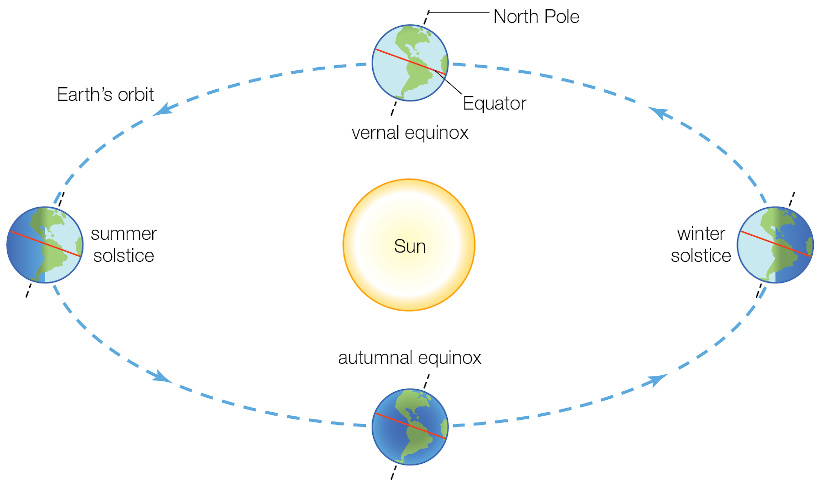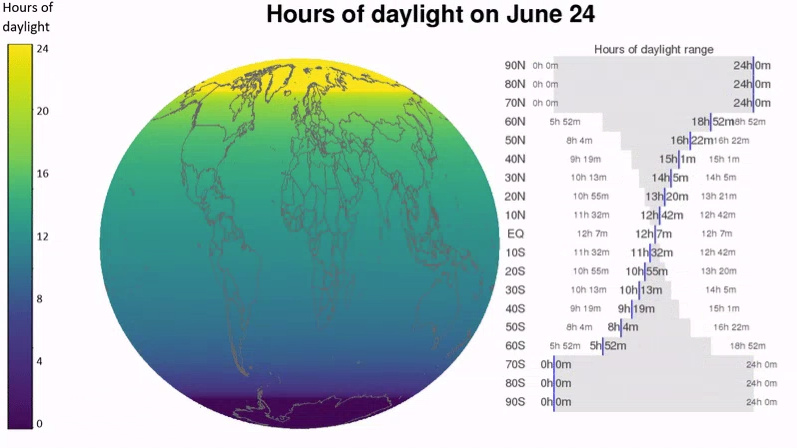Energy
Soaking up the Sun: Visualizing the Changing Patterns of Daylight in One Year
The darkest days are upon the residents of the Northern Hemisphere as daylight dwindles and the night lingers longer. Meanwhile, those in the Southern Hemisphere bask in their warmest and longest days—and those at the Equator continue to observe consistent days and nights.
These changing lengths of days and nights depend on where you are on Earth and the time of year. The tilt of the Earth’s axis and its path around the sun affect the number of daylight hours.
Today’s post highlights two simple and elegant animations that help demonstrate how different latitudes experience the sun’s light over the course of one year. The first comes from Reddit user harplass, while the second comes from data scientist Neil Kaye.
Longer and Shorter Days
The Ancient Greeks envisioned the movement of the sun as a Titan named Helios who rode across the sky in a horse-drawn chariot, illuminating the known world below. A rosy-fingered dawn would herald his imminent arrival, while the arrival of the dusk god Astraeus, ever on Helios’ heels, marked the passage of day into night.
Today, time is not at the whims of Greek mythology but by the measurable and consistent movement of celestial bodies. A day on Earth is 24 hours long, but not every day has 12 hours of daylight and 12 hours of night. The actual time of one Earth rotation is a little shorter–about 23 hours and 56 minutes.
Daytime is shorter in winter than in summer, for each hemisphere. This is because the Earth’s imaginary axis isn’t straight up and down, it is tilted 23.5 degrees. The Earth’s movement around this axis causes the change between day and night.
During summer in the Northern Hemisphere, daylight hours increase the farther north you go. The Arctic gets very little darkness at night. The seasonal changes in daylight hours are small near the Equator and more extreme close to the poles.
Length of a Rotation: Equinoxes and Solstices
There are four events that mark the passing stages of the sun, equinoxes and solstices.
The two solstices happen June 20 or 21 and December 21 or 22. These are the days when the sun’s path in the sky is the farthest north or south from the Equator. A hemisphere’s winter solstice is the shortest day of the year and the summer solstice the year’s longest.

In the Northern Hemisphere the June solstice marks the start of summer: this is when the North Pole is tilted closest to the sun, and the sun’s rays are directly overhead at the Tropic of Cancer.
The December solstice marks the start of winter when the South Pole is tilted closest to the sun, and the sun’s rays are directly overhead the Tropic of Capricorn.
The equinoxes happen around March 21 and September 23. These are the days when the sun is exactly above the Equator, which makes day and night of equal length.
Stand in the Place Where You Are
It is always darkest before the dawn, and every passing of solstice marks a time of change. As the Northern Hemisphere heads into the winter holiday season, it also marks the advent of longer days and the inevitable spring and summer.
The lengths of days and nights are constantly changing, but every one will get their time in the sun, at some point.
Energy
The World’s Biggest Nuclear Energy Producers
China has grown its nuclear capacity over the last decade, now ranking second on the list of top nuclear energy producers.

The World’s Biggest Nuclear Energy Producers
This was originally posted on our Voronoi app. Download the app for free on Apple or Android and discover incredible data-driven charts from a variety of trusted sources.
Scientists in South Korea recently broke a record in a nuclear fusion experiment. For 48 seconds, they sustained a temperature seven times that of the sun’s core.
But generating commercially viable energy from nuclear fusion still remains more science fiction than reality. Meanwhile, its more reliable sibling, nuclear fission, has been powering our world for many decades.
In this graphic, we visualized the top producers of nuclear energy by their share of the global total, measured in terawatt hours (TWh). Data for this was sourced from the Nuclear Energy Institute, last updated in August 2022.
Which Country Generates the Most Nuclear Energy?
Nuclear energy production in the U.S. is more than twice the amount produced by China (ranked second) and France (ranked third) put together. In total, the U.S. accounts for nearly 30% of global nuclear energy output.
However, nuclear power only accounts for one-fifth of America’s electricity supply. This is in contrast to France, which generates 60% of its electricity from nuclear plants.
| Rank | Country | Nuclear Energy Produced (TWh) | % of Total |
|---|---|---|---|
| 1 | 🇺🇸 U.S. | 772 | 29% |
| 2 | 🇨🇳 China | 383 | 14% |
| 3 | 🇫🇷 France | 363 | 14% |
| 4 | 🇷🇺 Russia | 208 | 8% |
| 5 | 🇰🇷 South Korea | 150 | 6% |
| 6 | 🇨🇦 Canada | 87 | 3% |
| 7 | 🇺🇦 Ukraine | 81 | 3% |
| 8 | 🇩🇪 Germany | 65 | 2% |
| 9 | 🇯🇵 Japan | 61 | 2% |
| 10 | 🇪🇸 Spain | 54 | 2% |
| 11 | 🇸🇪 Sweden | 51 | 2% |
| 12 | 🇧🇪 Belgium | 48 | 2% |
| 13 | 🇬🇧 UK | 42 | 2% |
| 14 | 🇮🇳 India | 40 | 2% |
| 15 | 🇨🇿 Czech Republic | 29 | 1% |
| N/A | 🌐 Other | 219 | 8% |
| N/A | 🌍 Total | 2,653 | 100% |
Another highlight is how China has rapidly grown its nuclear energy capabilities in the last decade. Between 2016 and 2021, for example, it increased its share of global nuclear energy output from less than 10% to more than 14%, overtaking France for second place.
On the opposite end, the UK’s share has slipped to 2% over the same time period.
Meanwhile, Ukraine has heavily relied on nuclear energy to power its grid. In March 2022, it lost access to its key Zaporizhzhia Nuclear Power Station after Russian forces wrested control of the facility. With six 1,000 MW reactors, the plant is one of the largest in Europe. It is currently not producing any power, and has been the site of recent drone attacks.
-

 Maps2 weeks ago
Maps2 weeks agoMapped: Average Wages Across Europe
-

 Money1 week ago
Money1 week agoWhich States Have the Highest Minimum Wage in America?
-

 Real Estate1 week ago
Real Estate1 week agoRanked: The Most Valuable Housing Markets in America
-

 Markets1 week ago
Markets1 week agoCharted: Big Four Market Share by S&P 500 Audits
-

 AI1 week ago
AI1 week agoThe Stock Performance of U.S. Chipmakers So Far in 2024
-

 Automotive2 weeks ago
Automotive2 weeks agoAlmost Every EV Stock is Down After Q1 2024
-

 Money2 weeks ago
Money2 weeks agoWhere Does One U.S. Tax Dollar Go?
-

 Green2 weeks ago
Green2 weeks agoRanked: Top Countries by Total Forest Loss Since 2001















